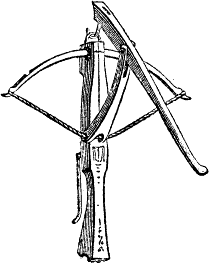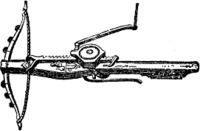Crossbow
|
|
A crossbow is a type of weapon that fires projectiles called crossbow bolts or quarrels. Most sources point to its invention in China, but the crossbow nonetheless played a significant role in the history of European medieval warfare and is still used in modern times for various purposes.
| Contents |
Description
A crossbow consists of a prod (similar in appearance to a bow) mounted on a stock similar to a rifle stock, which has a mechanism to wind and shoot its bolts. These bolts are typically called quarrels, and do not depend upon lift as arrows do. The stock and trigger of hand-held firearms may have been copied from crossbows.
Crossbow bolts must be made to have consistent weights as the mechanical process of engaging a bolt forces a more uniform process than that of using a bow and arrow. This consistent performance was part of what made the crossbow historically a significant force in warfare.
A crossbow contains a string which is held in place by a nut when the bolt is loaded and the cross bow is engaged (referred to as at full cock). Typically, the nut is at the end of the shelf (also called the bolt rest).
The prod ("bow") and stock of a crossbow were made of good hardwood, such as oak or hard maple. The central European bows were rather exotic as they were constructed of inlays as well as specialized woods. The prod is attached to the stock with hemp rope, linen, whipcord, or other strong cording. This cording is called the bridle of the crossbow. Much as a horse's bridle, it tends to loosen over time, and must be carefully respliced when appropriate.
The crossbow shelf is a flat section above the stock with a straight groove for the bolt to rest upon and travel along as it is shot.
The strings for a crossbow are typically made of strong fibers that would not tend to fray. According to W. F. Patternson, whipcord was very common; however linen, hemp, and sinew were used as well. Even cotton was tried with some success.
The crossbow also includes a trigger, which was later incorporated into rifles, muskets and other firearms. Triggers are known to have been used on crossbows from the early 1400s. Leonardo da Vinci designed many complicated triggers for crossbows, ultimately producing a "hair trigger" that could be shot with very little finger strength.
Crossbow bolts are lighter than arrows, but must be sealed with a varnish to ensure their consistent weight. They also typically only have two fletches per bolt instead of three commonly seen on arrows. This prevents them from snagging on the crossbow nut as they are shot.
History
Manufacturing
ChineseCrossbow.JPG
The history of the crossbow is varied. By the 200s B.C., the crossbow (nu, 弩) was well developed and quite widely used in China, although there is also some historical and linguistic evidence suggesting its true origins to be in Southeast Asia. One of the most distinctive Chinese inventions on crossbows was the repeating crossbow (Chu-ko-nu), invented in 2nd Century AD but was used as late as China-Japan war of 1894-1895 by Manchurian troops. Roman bows tended to be ornate and well engineered, yet western European bowstocks that were produced 600 years later appeared to be nothing more than rough hewn slabs of wood.
The prod of a crossbow was made of wood or composite materials until the middle of the 15th century. The advantage of a simple wooden prod is that the bow as a whole was lighter in weight. Composite prods were made of horn, sinew and wood, and produced much larger draw weights. The draw weight is the tension that the string is under when the bow is engaged. Since the draw weight can be much more than a soldier might be able to pull, these crossbows generally include a winch device to cock them. It is the high draw weight (or poundage of a crossbow), which made the crossbow a formidable weapon in warfare. Since composite prods involved gluing material together which would have to withstand a great deal of stress, a slow drying time was essential. The strongest glues naturally took longer to dry. It was not uncommon for six months up to a year to be spent in ensuring a bow was dried properly.
In the later 1400s, steel manufacturing advanced significantly, and was more commonly used in spring production. A crossbow prod is actually a specialized form of a spring, although not a coiled spring. Steel prods became very common by the early 1500s as their performance was more uniform, except in very cold weather. About 1400 the use of the crossbow changed, with the butt end of the stock being placed on the shoulder for accuracy. By 1650, the cross bow looked like it had a rifle stock, and was used in a similar way. Makers of crossbows (arbalistmeisters) were making quite beautiful crossbow stocks by 1600. Some Belgian designs were as polished as those of modern Olympic rifles.
Use
Crossbow4.png
Crossbows were actively being used in European warfare from 800 to 1500 A.D. They supplanted bows in many European armies for a number of reasons. An expertly handled longbow had greater range, better accuracy, and a much faster rate of fire than an average crossbow, but the value of the crossbow came in its simplicity: it could be used effectively after a week of training, while a comparable single-shot skill with a longbow could take years. There was a saying that the best way to train an archer was to give a bow to his grandfather! The use of winches allowed soldiers to use and fire weapons with a draw weight far in excess of what they could have handled with a bow. Moreover, crossbows could be kept cocked and ready to shoot for some time, allowing crossbowmen to aim better and to "cover" a target area, while archers could not keep their powerful bows pulled for long periods of time.
Due to the long time required to reload a crossbow, users would sometimes make use of a pavise.
Pope Urban II banned the use of crossbow against Christians in 1097, and the Second Lateran Council did the same for arbalests in 1139. The cross-bow was seen as unchivalrous and a threat to social order, where a peasant could kill a noble anonymously; crossbow mercenaries were usually killed immediately on capture, unlike others who may be ransomed or let go. However, their effectivness made them an "evil" no one could afford to be without, but usually in the form of hired foriegn mercenaries.
Crossbows were eventually replaced in warfare by gunpowder weapons. Early guns had slower rates of fire and much worse accuracy than contemporary crossbows.
Modern crossbows are still used for target shooting and in some places for hunting. They are made of the same composite materials as modern bows.
The phrase "a bolt out of the blue" meaning a sudden event may mean a crossbow bolt arriving without warning from a distance away; or it may mean the rare but known event of lightning falling from a clear sky.



